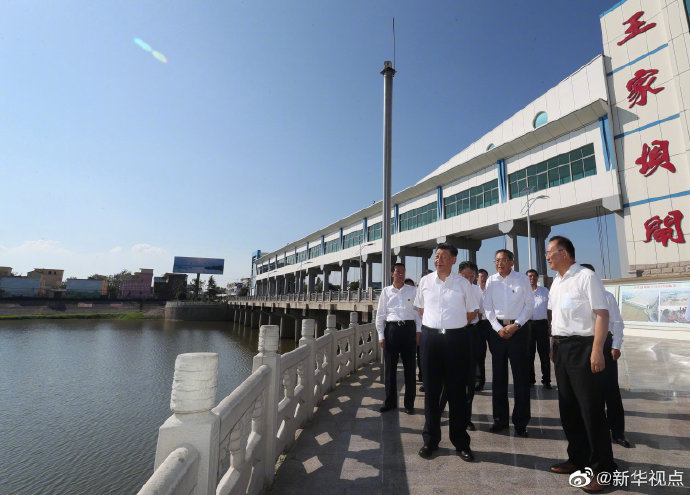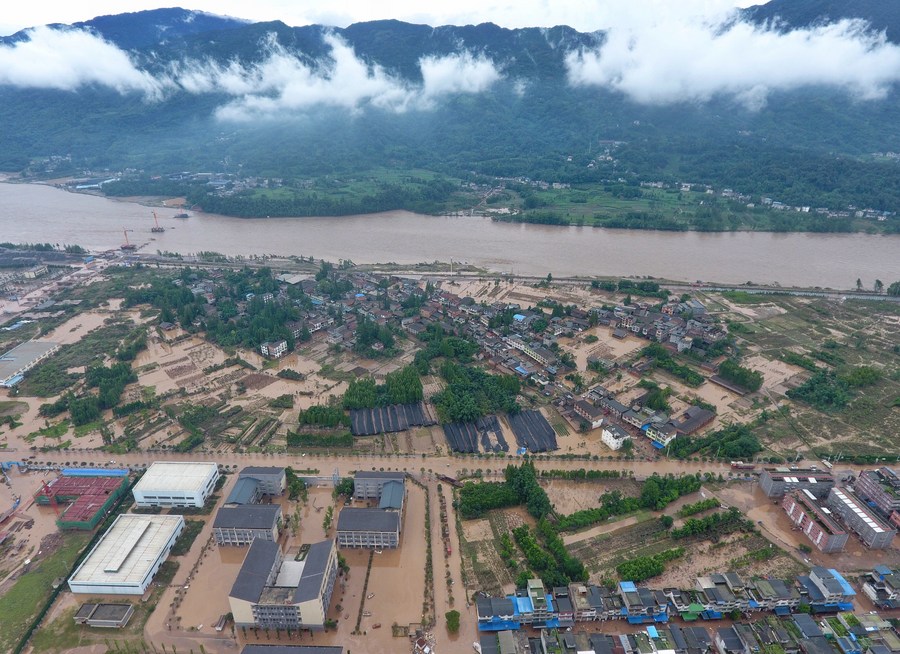


Xi Jinping on Tuesday inspected east China's Anhui Province. (Xinhua)
BEIJING, Aug. 18 (Xinhua) -- Chinese President Xi Jinping inspected east China's Anhui Province Tuesday. Xi's tour came at a time when the country is forging ahead with its economic resumption amid dual challenges of flood relief and regular epidemic control.
While uncertainties remain regarding the outlook of the global economic recovery, China's resilient economic performance has outshone the impact of the twin shocks.
In July, China's value-added industrial output went up by 4.8 percent year on year as factories stepped up production amid effective epidemic control. Retail sales of commodities edged up by 0.2 percent year on year, registering positive growth for the first time this year. Other key economic indicators also showed signs of recovery.
The latest data came out as local COVID-19 cases in Liaoning and Xinjiang were receding, thanks to the precise control measures.
Meanwhile, China has been sparing no effort to fight huge floods this summer, with massive mobilization, evacuations, and a top-level emergency response in several hard-hit provinces. The Ministry of Water Resources on Sunday urged greater efforts in flood control as another flood in the Yangtze River is expected to occur in its upper reaches.

Aerial photo taken on Aug.18, 2020 shows a view of the flood-hit Caoba Town in Ya'an City, southwest China's Sichuan Province. (Xinhua/Liu Kun)
How did China secure the safety and well-being of its people as the country fought on the two fronts of the floods and the virus? The answers range from the resilience of its economy to the edges of its governance system.
As the second-largest economy in the world with the most complete supply chain, China has sufficient resources and space to weather short-term shocks, and is capable of recovering at a fast pace once the situation is under control. For instance, thanks to the growth of the economic volume and the upgrading of flood prevention and disaster relief facilities, China's direct economic losses caused by the floods as a percentage of GDP showed a downward trend during the five large-scale floods it experienced since 1997, with the latest one in 2016 causing a direct economic loss of less than 0.5 percent of GDP.
Concerns over China's food shortages amid the ongoing global pandemic and the floods should also be dispelled. The stockpile of rice and wheat, two staple grains of the country, can feed the whole population for one year, with the per capita share of grain much higher than the international food security standard.
The ability to pool resources for major projects is another key factor contributing to China's success in containing the epidemic and winning the battle against the floods.
China's centrally-administered state-owned enterprises swiftly shifted production lines to essential materials like masks and disinfectants during the anti-virus war, contributing significantly to the total production capacity. The Three Gorges project, a multi-functional water-control system built with an enormous input of resources and technological prowess of the country, has been effective in controlling floods on the Yangtze River thanks to its precise scheduling of water discharges from the reservoir.

Workers examine the melt-blown nonwoven fabric, a key material for masks, made on the newly built production line at a factory of Sinopec, in Yizheng, east China's Jiangsu Province, March 29, 2020. (Photo by Liu Yufu/Xinhua)
Behind these efforts is the people-centered development philosophy of the Communist Party of China, which has won the firm support of the Chinese people.
According to the 2020 Edelman Trust Barometer, China has once again secured the top spot among 28 developed and emerging markets surveyed worldwide, including the United Kingdom, the United States, and India, with a record high public confidence in its government, business, media, and NGOs.
China's economic recovery, however, still faces external pressure amid the global spread of COVID-19, while domestic demand needs further expansion. The pressure on the employment situation remains as the number of fresh graduates hit a record high of 8.74 million this year, and some small businesses are still facing difficulties in production and operation.
In any case, there are reasons to feel optimistic. While there is no one-size-fits-all approach to tackle the difficulties various countries are facing, China's experience of juggling the floods and the coronavirus and its firm commitment to the opening-up policy are inspiring. With boosted confidence and expectation, China's market of 1.4 billion consumers will maintain the recovering momentum in the second half of the year, and its recovery will bring huge benefits to the world.

 Award-winning photos show poverty reduction achievements in NE China's Jilin province
Award-winning photos show poverty reduction achievements in NE China's Jilin province People dance to greet advent of New Year in Ameiqituo Town, Guizhou
People dance to greet advent of New Year in Ameiqituo Town, Guizhou Fire brigade in Shanghai holds group wedding
Fire brigade in Shanghai holds group wedding Tourists enjoy ice sculptures in Datan Town, north China
Tourists enjoy ice sculptures in Datan Town, north China Sunset scenery of Dayan Pagoda in Xi'an
Sunset scenery of Dayan Pagoda in Xi'an Tourists have fun at scenic spot in Nanlong Town, NW China
Tourists have fun at scenic spot in Nanlong Town, NW China Harbin attracts tourists by making best use of ice in winter
Harbin attracts tourists by making best use of ice in winter In pics: FIS Alpine Ski Women's World Cup Slalom
In pics: FIS Alpine Ski Women's World Cup Slalom Black-necked cranes rest at reservoir in Lhunzhub County, Lhasa
Black-necked cranes rest at reservoir in Lhunzhub County, Lhasa China's FAST telescope will be available to foreign scientists in April
China's FAST telescope will be available to foreign scientists in April